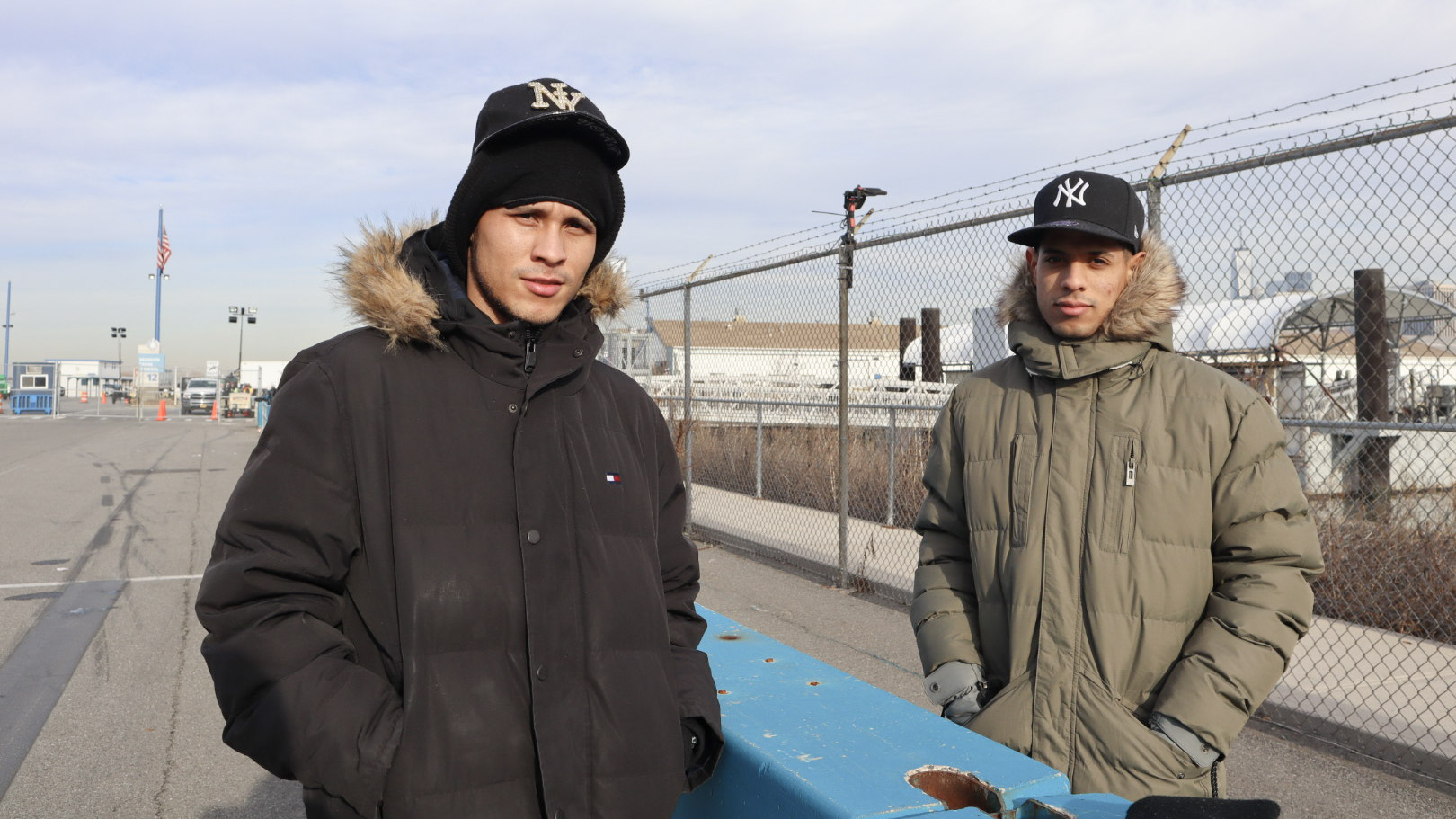On Wednesday night police cleared an encampment of migrant men outside the Watson Hotel on West 57th Street after they refused to move to a shelter for migrants at the Brooklyn Cruise Terminal in Red Hook.
Some migrants who were staying at the Manhattan hotel had traveled to the Brooklyn Cruise Terminal Humanitarian Center and returned after they saw the conditions, and word spread quickly that the facility seemed unfit, with too many people squeezed together into a congregate setting. Some compared it to the notorious border detention centers nicknamed the “ice box.”
Tensions rose between Mayor Eric Adams’ administration and the advocates and migrants outside the hotel, culminating in the police action. But migrants staying at the Red Hook shelter that Documented spoke to Thursday said they were appreciative of the safe place to sleep and are mostly just focused on finding work.
Also Read: Migrants Opt to Sleep on NYC Streets Instead of “Inhumane” Center at Brooklyn Cruise Terminal
“Honestly, they have helped us a lot,” Daniel Fernandez, a migrant from Venezuela, said in Spanish. Fernandez, 23, has been in New York for about three months and said that he did not have any complaints against the government. “We are privileged in that they are helping us,” he said.
Gleibert Veliz, a 20-year-old Venezuelan migrant, said that he embraced any support he was given. “I couldn’t turn that down,” he said, adding that in Red Hook, the shelter serves them food, is equipped with a game room, WiFi, TVs — and even ping pong tables. “They look after us well,” he said.
The Commissioner for the Mayor’s Office of Immigrant Affairs (MOIA), Manuel Castro, said the City has been battling misinformation about the facility. The facility was specifically intended to meet the needs of migrants, he explained outside the Watson Hotel.
“For me it’s important that they understand that we’re doing this for them to be in a safe environment where they can access resources,” Castro told the press.
But the NYC facility is not without its shortcomings, migrants said. Among the complaints, several migrants said it is cold throughout the night. Veliz said he had to sleep with his winter jacket on because his cot is near the entrance of the facility where it gets especially cold. “We get a little blanket but it doesn’t warm us up a lot.”
Catalina Cruz, an assemblywoman for the 39th District, said on Twitter that she toured the facility on Thursday, and spoke with about half a dozen people staying there — all of whom also expressed they were grateful to New York for the resources provided.
But, she added: “That doesn’t mean that this set up is ok. That doesn’t mean we’ve done enough for them. While this is an emergency situation our federal government, state and city could be doing much more.”
In interviews with Documented, migrants often brought up the terminal’s remote location from the subway. Gale Brewer, the City Council Member for District 6 in Manhattan, said the City runs a shuttle to the Barclays Center in Brooklyn, but acknowledged that the Red Hook location was far from the subway or any commercial strips. She also noted migrants have not been given metro cards. “More can be done to orient people to the area,” she said.
Free round-trip ferry tickets have also been provided every day for migrants, according to Fabien Levy, a spokesperson for the Mayor’s Office.
While some migrants said the shuttle service and the free ferry were helpful, they missed the accessibility Manhattan offered. “Over there, at least it was easier for us because of the train,” Fernandez said. “You would get to the train faster and then go in whatever direction you needed to.”
The Red Hook shelter has the capacity to house 1,000 people, has about 100 bathroom stalls and has heated trailers for showers, New York State Senator Andrew Gounardes, who represents the 26th Senate District that includes Red Hook, said after visiting the center.
Hundreds of cots are lined up in one space inside the facility, migrants staying at the facility said. Men staying in Red Hook also have to exit the center and walk outside to access the showers, they said. Press has not been allowed inside the center.
“The bad thing about this place is just that there’s no privacy,” said Luis Macias, a 23-year-old Ecuadorian migrant who arrived in New York about two months ago.
Cruz, the Assemblywoman, suggested that at the “bare minimum” cots should be set up farther apart from each other to “provide folks with privacy and dignity.”
Brewer and Gounardes both described the center as clean and heated, and said there was easy access to medical care. Still, Gounardes said, “no one thinks this situation or site are ideal.”
On Wednesday night, police and the Department of Sanitation conducted a sweep of the sidewalk outside the Watson, but mutual aid organizations decried law enforcement’s handling of the situation.
South Bronx Mutual Aid said that migrants’ belongings were taken and destroyed and that organizers were “providing support to impacted migrants afterwards.” But Levy, the Mayor’s press secretary, said in a statement that no arrests were made and that the only belongings that were discarded were the ones left on the street.
Most of the migrants decided to board buses to the Brooklyn Cruise Terminal “immediately” on Wednesday night, Levy said, and six migrants chose to be ticketed to other cities. The remaining migrants “chose to go their own ways,” he said, noting that they could come back to the Red Hook facility if they chose to.
When Macias, the Ecuadorian migrant, was told to leave the Watson Hotel several days ago, he chose to join those protesting on the sidewalk outside the hotel instead of going to Red Hook immediately, he said. The commentary he had heard, including people calling the facility an “icebox,” worried him. “There was a moment where I paused and I was like, could that be true?” Macias said.

For a night, Macias slept on the street in front of the hotel, but the situation was becoming tougher outside. “I said, ‘I’d rather endure it over there [in Red Hook] and sleep in a cot than sleep on the street.”
When he arrived in Red Hook about two days ago, the conditions were better than what he expected. He felt safe, he said, and there was heating. Though there were aspects of the center that could be improved, he was content. “We have the necessities: a bed, warmth, food and somewhere to stay,” Macias said. “For us, the help that they’re giving us is good.”














